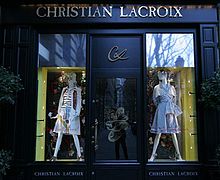Boutique



A boutique (French: [butik]) is "a small store that sells stylish clothing, jewelry, magnets or other usually luxury goods".[1] The word is French for "shop", which derives ultimately from the Greek ἀποθήκη (apothēkē) or "storehouse".[2][3]
The term boutique and also designer refer (with some differences) to both goods and services which are containing some element that is claimed to justify an extremely high price. As with the fine art market, and the use of art in money laundering schemes, national governments have to be concerned with boutique shops and the high pricing of boutique goods as instruments in fraud and other financial schemes.
Etymology and usage
The term "boutique" entered common English parlance in the late 1960s. In Europe, Avenue Montaigne and Bond Street were the focus of much media attention for having the most fashionable stores of the era.[4]
Some multi-outlet businesses (chains) can be referred to as boutiques if they target small, upscale market niches.[5] Although some boutiques specialize in hand-made items and other unique products, others simply produce T-shirts, stickers, and other fashion accessories in artificially small runs and sell them at high prices.
Lifestyle
In the late 1990s, some European retail traders developed the idea of tailoring a shop towards a lifestyle theme, in what they called "concept stores",[6] which specialized in cross-selling without using separate departments. One of the first concept stores was 10 Corso Como in Milan, Italy, founded in 1990, followed by Colette[7] in Paris and Quartier 206[8] in Berlin. Several well-known American chains such as Tiffany & Co. Urban Outfitters,[9][10] Dash, and The Gap,[11] Australian chain Billabong and, though less common, Lord & Taylor, adapted to the concept store trend after 2000.
See also
References
- ^ "boutique". Merriam-Webster's Dictionary. Retrieved October 1, 2014.
- ^ boutique, on Oxford Dictionaries
- ^ ἀποθήκη, Henry George Liddell, Robert Scott, A Greek-English Lexicon, on Perseus
- ^ Avalith. "Historypin - Tours - Carnaby Street, 1960s London". historypin.org. Archived from the original on 2016-07-15. Retrieved 2014-10-13.
- ^ "Starting a Boutique Business". Jalingo.co. Retrieved August 23, 2015.
- ^ "New retailers floor customers". Sydney Morning Herald. April 19, 2004. Retrieved 2008-10-29.
- ^ Katya Foreman. "Colette Unveils Redesigned Store Interior". WWD.
- ^ "Quartier 206". unlike.net. Archived from the original on 2008-10-25.
- ^ "Urban Outfitters: Dressed For Success". Forbes. December 20, 2007.
- ^ Wernick, Ellen (2003). "Urban Outfitters, Inc". International Directory of Company Histories.
- ^ "colette and Gap collaborate on new store (Vogue.co.uk)". Vogue UK. Archived from the original on 2008-12-01.
